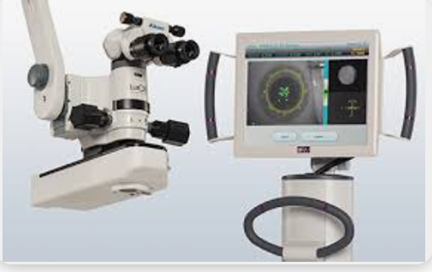Do you find it harder to read small print, drive at night, or recognize faces clearly? If so, you could be experiencing the early signs of cataracts. June is Cataract Awareness Month, a national campaign supported by the American Academy of Ophthalmology (AAO) to spread knowledge about cataracts and the life-changing benefits of early detection and treatment. With more than 24 million Americans over age 40 living with cataracts, it’s important to understand how the condition affects vision and the advanced solutions now available.
If you’re in California’s Inland Empire, you have access to one of the most advanced cataract treatment centers in the region: Pacific Eye Institute, offering the latest in Laser-Assisted Cataract Surgery (LACS).
Here’s everything you should know about cataracts, what to expect before and after surgery, and how cutting-edge laser technology is changing lives.
What Are Cataracts?
A cataract forms when the natural lens in your eye becomes cloudy, preventing light from passing through clearly. This can cause blurred or dim vision and may impact your ability to perform everyday tasks.
According to the American Academy of Ophthalmology, cataracts are the leading cause of blindness worldwide, and over half of all Americans will have cataracts by age 75. Though often age-related, cataracts can also result from eye injuries, diabetes, prolonged exposure to UV light, or use of certain medications like corticosteroids. Some of the most common symptoms of cataracts include cloudy or blurry vision, difficulty seeing at night, and faded or yellowing colors. You might also notice halos around lights, double vision in one eye, or the need for frequent changes in your eyeglass prescription. If these symptoms sound familiar, it may be time to schedule an eye exam, which you can start with a Cataract Self-Test.
How Cataracts Affect Your Daily Life
Without treatment, cataracts can make once-simple activities like reading, cooking, driving, or enjoying hobbies—more difficult or even unsafe. Many people find their independence slipping away gradually.
It’s not just a matter of poor vision cataracts can deeply impact your confidence, mobility, and quality of life.
Fortunately, there’s a safe and highly effective solution.
What Happens During Cataract Surgery?
Cataract surgery is one of the most commonly performed medical procedures in the U.S., with over 3 million surgeries done each year, and it boasts a very high success rate.
During the procedure:
- The cloudy natural lens is removed.
- It is replaced with a clear artificial intraocular lens (IOL).
- Most surgeries are done on an outpatient basis and take only 15–30 minutes per eye.
- The goal is simple: restore clear, sharp vision. But at Pacific Eye Institute, we take it a step further.
Introducing Laser-Assisted Cataract Surgery (LACS)
At Pacific Eye Institute, we’re proud to offer Laser-Assisted Cataract Surgery (LACS)—a leading-edge advancement in eye care technology.
What Makes LACS Different?
Traditional cataract surgery uses handheld instruments to make incisions and manually break up the cataract. In contrast, LACS uses a femtosecond laser to perform many of the critical steps of the surgery with enhanced precision.

Key Benefits of LACS:
- Greater precision and consistency: Laser incisions are more accurate than manual techniques.
- Gentler on the eye: The laser softens the cataract, making it easier to remove and leading to faster healing.
- Customized care: The laser maps your eye in real time, allowing for a highly tailored treatment.
- Enhanced outcomes: Especially when paired with premium IOLs, patients can experience better visual clarity with less dependence on glasses.
If you live in the Inland Empire, having access to LACS at Pacific Eye Institute means you don’t need to travel far for world-class technology and trusted expertise. Read more.
What to Expect: Before and After Surgery
Before surgery, your ophthalmologist will perform a detailed eye exam and measure your eye to select the most suitable IOL. You’ll also have a thorough consultation to discuss your lifestyle, vision goals, and available lens options. Pre-surgery instructions and medication guidelines will be provided so you’re fully prepared.
After surgery, most patients notice an improvement in vision within 24 to 48 hours. While full recovery may take a few weeks, the healing process is generally smooth. You’ll be prescribed eye drops to prevent infection and reduce inflammation. Protective eyewear and activity restrictions—such as avoiding heavy lifting or bending—may be recommended for a short period.
Follow-up visits will be scheduled to monitor your healing and ensure optimal results. Most patients return to normal activities within just a few days.
Life After Cataract Surgery
Many patients describe their vision after surgery as sharper, brighter, and more vibrant than they’ve experienced in years. Tasks like reading, using a computer, watching television, and driving become easier and more enjoyable. Colors appear more vivid, and overall visual clarity is significantly enhanced.
Perhaps most importantly, cataract surgery can restore your sense of freedom and independence. You’ll regain the confidence to do what you love—whether that’s gardening, traveling, or simply reading a book without squinting.
Conclusion
Cataract Awareness Month is a timely reminder to prioritize your vision health. If you’ve noticed changes in your eyesight, especially with age, schedule a comprehensive eye exam. With locations across the Inland Empire, Pacific Eye Institute is a trusted leader in advanced cataract care. Our board-certified ophthalmologists combine decades of experience with cutting-edge technology, including Laser-Assisted Cataract Surgery, to offer unmatched precision and results. We understand that each patient is unique, which is why we take the time to provide a customized treatment plan that fits your lifestyle, goals, and vision needs. From initial consultation to post-op care, your experience will be guided by compassion, expertise, and a commitment to excellence.








